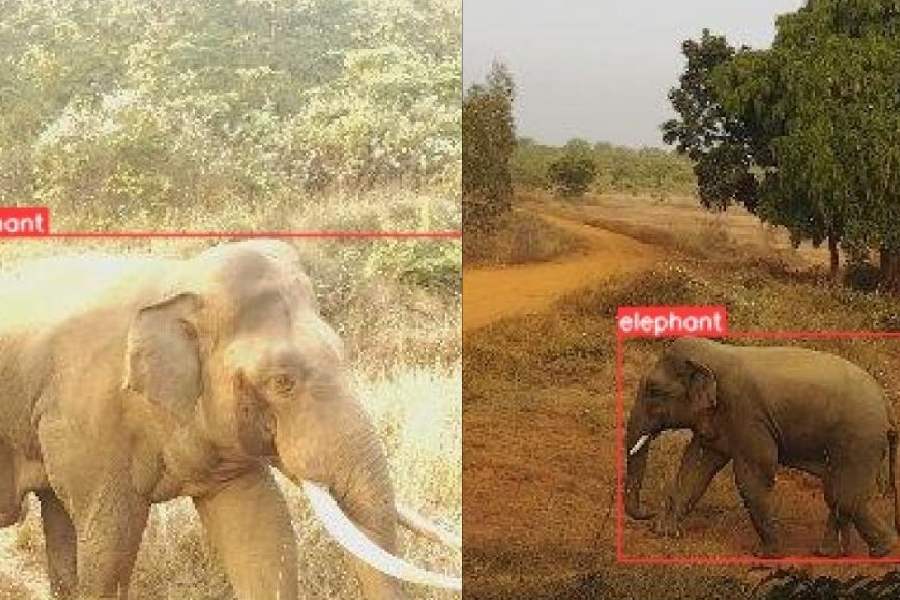Trap cameras installed in a pocket of Jhargram have not only captured images of elephants headed to human habitations but shared real-time alerts that helped the forest department save lives.
Thirty AI-powered cameras were placed in four forest ranges — Jhargram, Lodhashuli, Gidhni and Manikpara — between October 2023 and April 2024 as a pilot project.
Together, these places had reported at least four human deaths and several injuries caused by elephants in the same period in 2021-2022 and 2022-2023, said forest officials. But between October 2023 and April 2024, no death or injury was reported, they said.
The cameras detected elephants leaving forests to move along roads, trails and routes bordering human settlements. The main objective of the technology, called TrailGuard AI Camera alert system, was to send alerts in real time to the local forest field staff to improve the response time to a conflict situation, and simultaneously mobilise rapid response teams to prevent fatalities and injuries.
Cameras are usually used in population estimation exercises and to study the habitat distribution of a particular species. But using cameras to detect elephants and share real-time alerts is new in south Bengal, foresters said.
A top forest official of the state said the new technology has proven to be “very useful”. But the cost has to be brought down to enable its implementation on a wider scale, he
said.
RESOLVE, a US-based NGO that provides tech solutions to biodiversity and conservation issues, partnered with the state forest department for the pilot project, which was funded by the Japan International Cooperation Agency (Jica).
The same camera alert technology was earlier used in human-tiger conflict mitigation in Uttar Pradesh and Madhya Pradesh.
In Jhargram, the cameras were placed on the edge of the forests, the boundaries that elephants cross while moving towards villages.
Between October 2023 and April 2024, the 30 cameras together shared 266 real-time alerts on elephant movement.
“The forest department had clear guidelines. One of which was to reduce the chances of elephants going undetected when heading towards villages. Second, given the likelihood of detections of humans along the same routes in this multi-use landscape, they required the AI system to filter out human detections. Third, they also wanted the system to filter out smaller animals like wild boars and wolves,” said Sankarshan Rastogi of RESOLVE, the project manager.
“In the same period, there were over 33,000 human detections. Domestic water buffaloes, cattle, boar, village dogs, wolves, when combined, accounted for only 27 detections. But only elephant alerts were sent,” said Rastogi.
Interventions by rapid response teams were needed after 40 per cent of the alerts, said a forest official. In the remaining 60 per cent cases, the location and direction of the elephant/s suggested that the individual or herd was moving from one forest patch to another.
Some of the points mentioned in the project report submitted to the forest department:
- More than 70 per cent of the detections occurred at only six sites at the forest-village interface across the entire the Gidhni and Jhargram-Lodhasuli forest ranges
- Around 28 per cent of the elephant detections were during the day time and nearly 72 per cent at night
- Most detections were of lone bulls (114), followed by nearly equal numbers of small groups (87) and large herds (65).
Debal Ray, the chief wildlife warden of Bengal, said the AI-powered cameras had “proven to be very efficient and useful”, but gave a rider.
“The cameras are very costly. Unless the cost comes down, wide-scale implementation will be difficult, even if we consider just south Bengal,” Ray told this newspaper.
The report says the cost of deploying 100 such cameras will be roughly the same as that of capturing and radio-collaring two conflict-prone lone bulls.
“We are constantly working on lowering the cost. As production goes up, the cost will come down. We are discussing that with the forest department,” Rastogi said.
Pankaj Suryawanshi, the divisional forest officer of Jhargram, described the pilot project as a “great learning experience”.
But the requirement was on a much larger scale, he said. “The cameras, if mounted on drones, can be of greater use. They are not static then. But all these are still in the planning stage,” he said.
Aritra Kshettry, national lead for elephant conservation, WWF-India, said Trailguard AI or similar products “with a short detection range (about 30m) but accurate image identification can be useful near or around human settlements to warn people of the presence of elephants”.
“But affordability and ease of operation also needs to be considered to ensure seamless adoption by the local communities and forest departments,” said Kshettry, who was not associated with this project.










